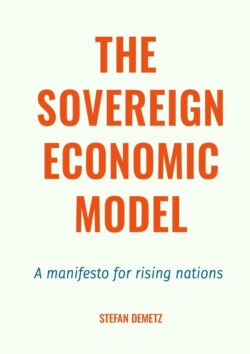Читать книгу The Sovereign Economic Model. A manifesto for rising nations - Stefan Demetz - Страница 18
Economics of the sovereign economic model
How to Apply the Sovereign Economic Model by Level of Development
ОглавлениеThe Sovereign Economic Model contains concepts that have usually been applied in developed nations when they were developing and emerging countries themselves. Most countries have had to protect their markets, such as the US at the end of the 19th and beginning of the 20th centuries; most European countries after World War II; Japan and South Korea slightly later; and many countries in Africa and Latin America in the 1960s and 1970s when, after being colonies, they became independent.
Countries in the developing phase should focus on these priorities:
• Agriculture, natural resources, and infrastructure
• Low-to-medium-technology industry
• One high-tech industry as a national priority
Emerging countries should ponder the following policies:
• Maintain the focus on agriculture, natural resources, and infrastructure.
• Increase focus on the high-value medium-high technology industry.
• Focus on at least one high-value high-tech industry as a national priority.
• Start focusing on the knowledge economy.
Even developed nations, as they stand, have not completed their evolution curve. Many argue that they have started a regression in the past decade, like a playground swing in a park hitting its peak below potential, then stopping and moving backwards. Over-financialization has crept in, and the focus on their core industries and wealth-creating economic sectors has been lost. Speculative investments and other unproductive allocations of money have created more industries of hype than ever. The valuation of assets is wrongly given a higher priority than production, employment, and profits. Government policies and national economic KPIs have changed to achieve quick Pyrrhic victories in perception, but not substance or progress. The toxic addiction to debt, especially long-term debt, is sapping wealth as government interest payments. Unfortunately, debt produces a near-zero percentage of GDP increase and no wealth. In many companies with legendary heritage, products have been watered down and their intrinsic quality and value characteristics flushed out to increase sales and maximize production. The management of developed countries and their business itself is being distracted by ever-increasing marginal issues and useless new fads. Actions of management are big announcements, costs, and time wasted, but without concrete changes or results moving the economic wagon forward. Inefficiencies have crept into the system through outdated infrastructure, outdated processes, and outdated systemic operators, both government and connected business. Bureaucracy and red tape in many countries still require people to transport paperwork in person. People need to visit five different agencies in five different offices during office hours instead of communicating through an online system, which can process such data in a few seconds or minutes at any time of day or night. Education systems have softened to adapt to these new realities instead of insisting on meritocracy and improving the academic curricula, and levels have been lowered by the Bologna Process and Common Core curricula. Rigorous academic tradition was thus demoted to let anyone take part instead of maintaining rigor through an academic selection process.
To roll back, most countries need to take stock and refocus on the core systemic issues of their economies. Cures for rotting economies are needed. It is hard to take stock of bad habits and reassess priorities, but it needs to be done. A list of action steps will need to be prepared and started to change the status quo and introduce new best practices. The following might be some of these steps:
• Increase speed and efficiency of government services for business and people.
• Remove inefficient and unproductive capital allocations from the market.
• Return to conservative economic policies with frugal use of debt.
• Change economic KPIs and steer government support toward them.
• Rebuild infrastructure to include the latest technologies.
• Keep the focus on wealth-generating economic sectors: agriculture, natural resources, infrastructure, industry, and the knowledge economy.
• Return the focus to high-value, high-wealth industry sectors.
• Focus on at least one high-tech industry as a national priority.
• Revert the education system to old-style meritocracy, but implement new-style curricula to support the wealth-creating industry sectors first.
Depending on the stage of development and structure of their economy, countries need to implement economic policies that benefit their real economic growth.
